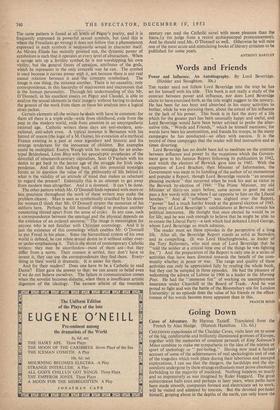A New Critic
Maria Cross. By Donat O'Donnell. (Chatto & Windus. 21s.) IT is a relief to find a Catholic critic who does it the hard way; and does it brilliantly at that: Donat O'Donnell's studies of imaginative patterns in a group of modern Catholic writers are far from the curt comments of the Church censorious (" very pernicious, morally base," was what it once said about Mauriac) or the quirks and quiddities of learned (but irrelevant) Neo-Thomists. Mr. O'Donnell's own attitude appears to be that of an anti-clerical Catholic, a point of view which has highly respectable antecedents and which enables him to approach his eight authors with understanding and independence. He comes at these modern Catholics—Mauriac, Bernanos, Bloy, Greene, O'Faolain, Waugh, Claude' and Pdguy—from a slight angle, and this incipient conflict gives his criticism tension. He even succeeds in making Peguy, who is usually a fearful bore, interesting and at moments compre- hensible.
One service Mi.. O'Donnell does us all. He shows how to write literary criticism which, while accepting and using Freud, does not prejudge the philosophical issues raised by that acceptance. Much of Peguy, for instance, can be interpreted along Freudian lines. There is a death wish and a desire to return to infancy which are two opposing facets of the same urge towards. an annihilation involving at once safety and danger. On the religious level Peguy centres this 'safety/danger complex on the person of Christ, Christ who is both the powerful Saviour and the humble Son of Man. The same pattern is found at all levels of Peguy's poetry, and it is frequently expressed in powerful sexual symbols, but (and this is where the Freudians go wrong) it does not follow that a phenomenon expressed in such symbols is necessarily sexual in character itself. As Mircea Eliade has recently pointed out, the dynamic power of symbolism is such that it operates at every level of abstraction. When a savage sets up a fertility symbol, he is not worshipping his own virility, but the general forces of creation, attributes of the gods, which he represents in the only concrete way he can. The symbol is used because it carries power with it, not because there is any real causal relation between it and the concepts symbolised. The image is one thing, the instance another. There is no causality, only correspondence, in this hierarchy of macrocosm and microcosm that is the human personality. Through his understanding of this Mr. O'Donnell, in his excellent essays on Peguy and Claudel, is able to analyse the sexual elements in their imagery without having to deduce the genesis of the work from them or force his analysis into a logical strait-jacket.
Certain elements all-the writers he•deals with have in common: for them all there is a triple exile—exile from childhood, exile from the past in the modern world, exile from emotion in an unsympathetic rational age. Catholic writers these days are anti-modern, anti- rational, anti-adult even. A typical instance is Bernanos with his hatred of reason (the logic of a M. Ouine), his evocation of a mythical France existing in a past at once legendary and historic and his strange tenderness for the innocence of children. But examples could be multiplied: Evelyn Waugh with his nostalgia for an arche- typal Brideshead, Leon Bloy with his apocalyptic prophecies of the downfall of nineteenth-century capitalism, Sean O'Faolain with his desire to get back to the heroic age of the struggle for Irish inde- pendence. And all this harking back, all this potential nostalgia forces us to question the value of the philosophy of life behind it: what is the validity of an attitude of mind that makes us reluctant to regard the present? Essentially this is an attempt to get away from modern man altogether. And it is doomed. It can't be done.
The other pattern which Mr. O'Donnell finds repeated with more or less precision throughout the work of these writers may make the problem clearer. Man Is seen as symbolically crucified by his desire for woman (I think that Mr. O'Donnell strains the resources of his authors here. Perhaps he felt himself obliged to produce another connecting thread apart from the sense of exile). In any case, such a correspondence between the spiritual and the physical depends on the existence of an ordered universe. The image is meaningless for anyone who is not familiar with Christian cosmology. And it is just the existence of this cosmology which enables Mr. O'Donnell to put Freud in his place. Since the hierarchical system of his own world is defined, he can relate sexual desire to it without either over- or under-emphasising it. This is the secret of contemporary Catholic writers: they may be unorthodox—most of them are—but they differ from a norm. Their cosmos is settled, they don't have to invent it, they can use the correspondences they find there. Every- thing in their world is dramatic. It is easier for them. And for their readers? Does one have to be a Catholic to read Dante? Eliot gave the answer to that: we can assent to belief even if we do not believe ourselves. The failure in communication comes when the novelist becomes didactic, when there is insufficient artistic digestion of the ideology. The earnest atheist of the twentieth century can read the Catholic novel with more pleasure than the hiera.hy (to judge from a recent archiepiscopal pronouncement). And he should read Mr. O'Donnell as well. Otherwise he will miss one of the most acute and stimulating books of literary criticism to be published for some years.
ANTHONY HARTLEY











































 Previous page
Previous page